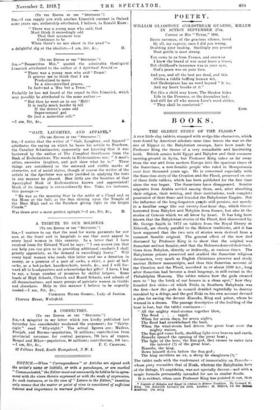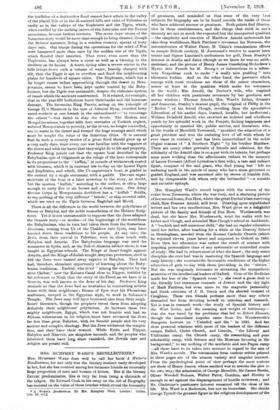BOOKS.
THE OLDEST STORY OF THE FLOOD.*
A FEW little clay tablets, stamped with wedge-like characters, which were found by American scholars come time before the war on the site of Nippur in the Babylonian swamps, have been made by Professor King the theme of a very remarkable and fascinating book. British armies hold Egypt and Babylon and their common meeting-ground in Syria, but Professor King takes us far away from the war and from modern Europe into the spacious times of the Sumerians, a non-Semitic people who ruled in Mesopotamia over four thousand years ago. He is concerned especially with the Sumerian story of the Creation and the Flood, preserved on one of these little tablets, which has been published for the first time since the war began. The Sumerians have disappeared. Semitic migrants from Arabia settled among them, and, after absorbing their religion, their writing, and their institutions, took complete possession of their State and founded the Babylonian Empire. But the influence of the long-forgotten people still persists, not merely in a familiar usage like our twenty-four-hour day, which Greece borrowed from Babylon and Babylon from Sumer, but also in the stories of Genesis which we all know by heart. It has long been known that the Babylonian stories of the Flood, first discovered by Mr. George Smith in 1872 on tablets from the Royal library at Nineveh, are closely parallel to the Hebrew traditions, and it has been supposed that the two sets of stories were derived from a common Semitic original. The general effect of the new find discussed by Professor King is to show that the original was Sumerian and not Semitic, and that the Hebrews derived their tradi- tions from Babylon, directly or indirectly, at various times. The Babylonian priests preserved and studied the Sumerian religious documents, very much as English Christians preserve and study ancient Hebrew manuscripts, and thus this Sumerian account of the Creation and the Flood, inscribed in or about 2100 B.c., long after Sumerian had become a dead language, is still extant in tha Philadelphia Museum. The tablet relates how the gods created men to " lay the brick of our houses in a clean spot," how they founded five cities—of which Eridu in Southern Babylonia was the first—how the gods in council deoided regretfully to destroy mankind by a deluge, and the god Enki on his own account devised a plan for saving the devout Ziusudu, King and priest, whom he warned in a dream. The passage descriptive of the building of the boat is lost, but the tablet continues :-
" All the mighty wind-storms together blew, The flood . . . raged.
When for seven days, for seven nights, The flood had overwhelmed the land, When the wind-storm had driven the great boat over the mighty waters, The Sim-god came forth, shedding light over heaven and earth. Ziusudu opened the opening of the great boat ;
The light of the hero, the Sun-god, (he) causes to enter into
the interior (I) of the great boat.
Ziusudu, the king, Bows himself down before the Sun-god ; The king sacrifices an ox, a sheep he slaughters M."
The tablet ends with the conferment of immortality on Ziusudu- whew piety resembles that of Noah, whereas the Babylonian hero of the Deluge, Ut-napishtim, was not specially devout—and with a magic formula presumably intended for use in similar floods.
It is evident, when once Professor King has pointed it out, that
• Ledende of Babylon and ithipt in relation to Hebrew Tradition. BY Leonard W. King. The Schweich Lectures for 1916. London: H. Milford, for the British Academy, (Si. mt.' the tradition of a destructive flood cannot have arisen in the valley of the placid Nile or in the ill-watered hills and vales of Palestine so easily as in the valleys of the Euphrates and the Tigris, which, when swelled by the melting snows of the Armenian and the Taurus mountains, become furious torrents. The seven days' storm of the Sumerian story would be more than enough to bring disaster, though the Hebrew narrator, living in 'a rainless country, speaks of forty days' rain. Our troops during the operations for the relief of Kut were hampered more than once by the sudden rise of the Tigris, which flooded their trenches. That river, even more than the Euphrates, has always been a. curse as well as a blessing to the dwellers on its banks. A warm spring after a severe winter in the hills brings down such a volume of water, heavily charged with silt, that the Tigris is apt to overflow and flood the neighbouring plains for hundreds of square miles. The Euphrates, which has a far longer course before approaching through the desert to Meso- potamia, seems to have been kept under control by the Baby- lonians, but the Tigris was untamable, despite the elaborate system of canals which the ancients constructed. It is related, for example,, that in the year 629 both rivers burst theirbanka and did immense. damage. The Swsanian King Parwiz, acting on the principle of George IL's Ministers in the ease of Admiral Byng, crucified forty canal-workers at one breach in the embankment—" to encourage the others "—but failed to stay the floods. The Moslem and Mongol invasions, together with four centuries of Turkish neglect,, reduced Mesopotamia to poverty, as the rivers, no longer controlled,, ran to waste in the desert and formed the huge swamps amid which must be sought the ruins of the Sumerian cities. It is natural that in such a country stories of a great flood should grow up at a very early date, since every one was familiar with the vagaries of the rivers and with the harm that the3rmight do to life and property. Professor King points out that the square boat described in the. Babylonian epic of Gilgamesh as the refuge of the hero corresponds' in its proportions to the " kuffah," or coracle of wickerwork coated with bitumen, which is in constant use to-day on the Lower Tigris and Euphrates, and which, like Ut-napishtim's boat, is guided in the current by a single steersman with a paddle. The vast super- structure of the boat is a later accretion to the story, no doubt,
but the modern " according to the author, is often large enough to carry five or six horses and a dozen men. Our Army Service Corps in Mesopotamia doubtless has a " kuffah" flotilla, to say nothing of the very different " beleds," or skin-covered rafts, which are used on the Tigris between Baghdad and Mosul.
There is all the difference in the world between the polytheism of Sumer or Babylon and the noble monotheism of the Hebrew Scrip- tures. Yet it is not unreasonable to suppose, that the Jews adapted the Genesis story—or stories—of the beginnings of the world from. the Babylonians, who in turn had taken there from the Sumerians. Abraham, coming from Ur of the Chaldees into Syria, may have handed down these traditions to his people. At any rate, the Jews, from their arrival in Palestine, were in close touch with Babylon and Assyria. The Babylonian language was used for commerce in Syria, and, as the Tell-el-Amarna tablets show, it was taught in Egyptian schools. The Kings of Israel fought against Assyria, and the Kings of Judah sought Assyrian protection, until in 586 the Jews were carried away captive to Babylon. They had had, therefore, abundant opportunity of learning about the Baby- lonian traditions. Ezekiel, who lived " among the captives by the river Chebar," now the Kabaru Canal close to Nippur, testifies by his reference to. Noah that the story of the Flood, as we have it in Genesis, was well known to the Jews of his day. Professor King reminds us that the Jews bad no hesitation in contracting artistic loans with their neighbours ; Hiram of Tyre sent his Phoenician craftsmen, steeped in the Egyptian style, to work in Solomon's Temple. The Jews may well have borrowed also from their neigh- bours' literature, though the prophets saved them from adopting definitely their neighbours' polytheism. As between these two• mighty neighbours, Egypt, which was not Semitic and had an African substratum in its religion, must have attracted the Jews far less than great Babylon, with its Semitic people and its very ancient and complex theology. But the Jews withstood the tempta- tion, and they have their reward. While Eridu and Nippur, Babylon and Nineveh, are shapeless mounds, and the peoples who inhabited them have long since vanished, the. Jewish ram and religion are potent still.



































 Previous page
Previous page